Financial Audit: Professional Skepticism, Evidence, and Planning
VerifiedAdded on 2023/05/26
|7
|2522
|59
Homework Assignment
AI Summary
This assignment solution covers key aspects of financial auditing, starting with the importance of professional skepticism in identifying potential misstatements and fraud. It discusses the role of internal controls in preventing fraud, methods for testing the operating effectiveness of controls...

Question 1:
1. Professional Skepticism:
(Pcaobus.org, 2018) As per AS 1015, professional skepticism is defined as an attitude
that includes a question mind, being alert to the conditions which might indicate
possible misstatetement due to error or fraud, and a critical assessment of audit
evidence. (G and B, 2015) Professional skepticism, if adopted throughout the audit,
avoids the following errors usually committed by auditor.
Overlooking unusual circumstances
Over-generalizing when drawing conclusions from audit observations;
Using inappropriate assumptions in determining nature, timing and extent of
the audit procedures and evaluating the results thereof.
The auditor shall plan and perform an audit with professional skepticism recognizing
the circumstances which may exist that causes the financial statements to be
materially mis-stated.
2. The Wichita Store manager found the opportunity to commit the fraud in the
absence of proper internal controls. Allocation of duty of collection of payments to
some other person, system requiring periodic reconciliation of general ledger with
subsidiary books and periodic accounts confirmation with clients should have
mitigated this opportunity to commit fraud. Further a policy of acceptance of
payments in cash also lead to an opportunity.
3. Firstly while scrutinizing the ledgers, there was an adjustment entry to tally general
ledger balances with subsidiary ledger balances. Later during the analytical
procedures, the staff auditor found deviation in gross profit percentage between
main stores and branch. Later during discussion of audit findings, it was confirmed
that the representation given by stores manager is unreliable and then the audit
team has to expand their field work and trace the customer payments to subsidiary
ledger and general ledger.
4. The staff auditor clearly lacked professional skepticism since he accepted the
explanation offered by the store manager without performing further audit
procedures to obtain evidence that support claim of stores manager.
5. Companies undertook following measures to minimize ‘pressure’ and
‘rationalization’ sides of fraud triangle (Strategic Finance, 2015).
Reduction of ‘pressure’ dimension: The focus is shifted to include accomplishments
of more ethics-based matters than performance based matters (like total
shareholders return, or other financial performance metrics) when considering the
senior executives incentives and pay programs
Reduction of ‘rationalization’ dimension: Companies have included number of
programs into the list of efforts to avoid rationalization of improper behavior such as
ethics training tailored to the organization, annual surveys of employee attitudes,
and effective whistle blowing programmes.
1. Professional Skepticism:
(Pcaobus.org, 2018) As per AS 1015, professional skepticism is defined as an attitude
that includes a question mind, being alert to the conditions which might indicate
possible misstatetement due to error or fraud, and a critical assessment of audit
evidence. (G and B, 2015) Professional skepticism, if adopted throughout the audit,
avoids the following errors usually committed by auditor.
Overlooking unusual circumstances
Over-generalizing when drawing conclusions from audit observations;
Using inappropriate assumptions in determining nature, timing and extent of
the audit procedures and evaluating the results thereof.
The auditor shall plan and perform an audit with professional skepticism recognizing
the circumstances which may exist that causes the financial statements to be
materially mis-stated.
2. The Wichita Store manager found the opportunity to commit the fraud in the
absence of proper internal controls. Allocation of duty of collection of payments to
some other person, system requiring periodic reconciliation of general ledger with
subsidiary books and periodic accounts confirmation with clients should have
mitigated this opportunity to commit fraud. Further a policy of acceptance of
payments in cash also lead to an opportunity.
3. Firstly while scrutinizing the ledgers, there was an adjustment entry to tally general
ledger balances with subsidiary ledger balances. Later during the analytical
procedures, the staff auditor found deviation in gross profit percentage between
main stores and branch. Later during discussion of audit findings, it was confirmed
that the representation given by stores manager is unreliable and then the audit
team has to expand their field work and trace the customer payments to subsidiary
ledger and general ledger.
4. The staff auditor clearly lacked professional skepticism since he accepted the
explanation offered by the store manager without performing further audit
procedures to obtain evidence that support claim of stores manager.
5. Companies undertook following measures to minimize ‘pressure’ and
‘rationalization’ sides of fraud triangle (Strategic Finance, 2015).
Reduction of ‘pressure’ dimension: The focus is shifted to include accomplishments
of more ethics-based matters than performance based matters (like total
shareholders return, or other financial performance metrics) when considering the
senior executives incentives and pay programs
Reduction of ‘rationalization’ dimension: Companies have included number of
programs into the list of efforts to avoid rationalization of improper behavior such as
ethics training tailored to the organization, annual surveys of employee attitudes,
and effective whistle blowing programmes.
Paraphrase This Document
Need a fresh take? Get an instant paraphrase of this document with our AI Paraphraser
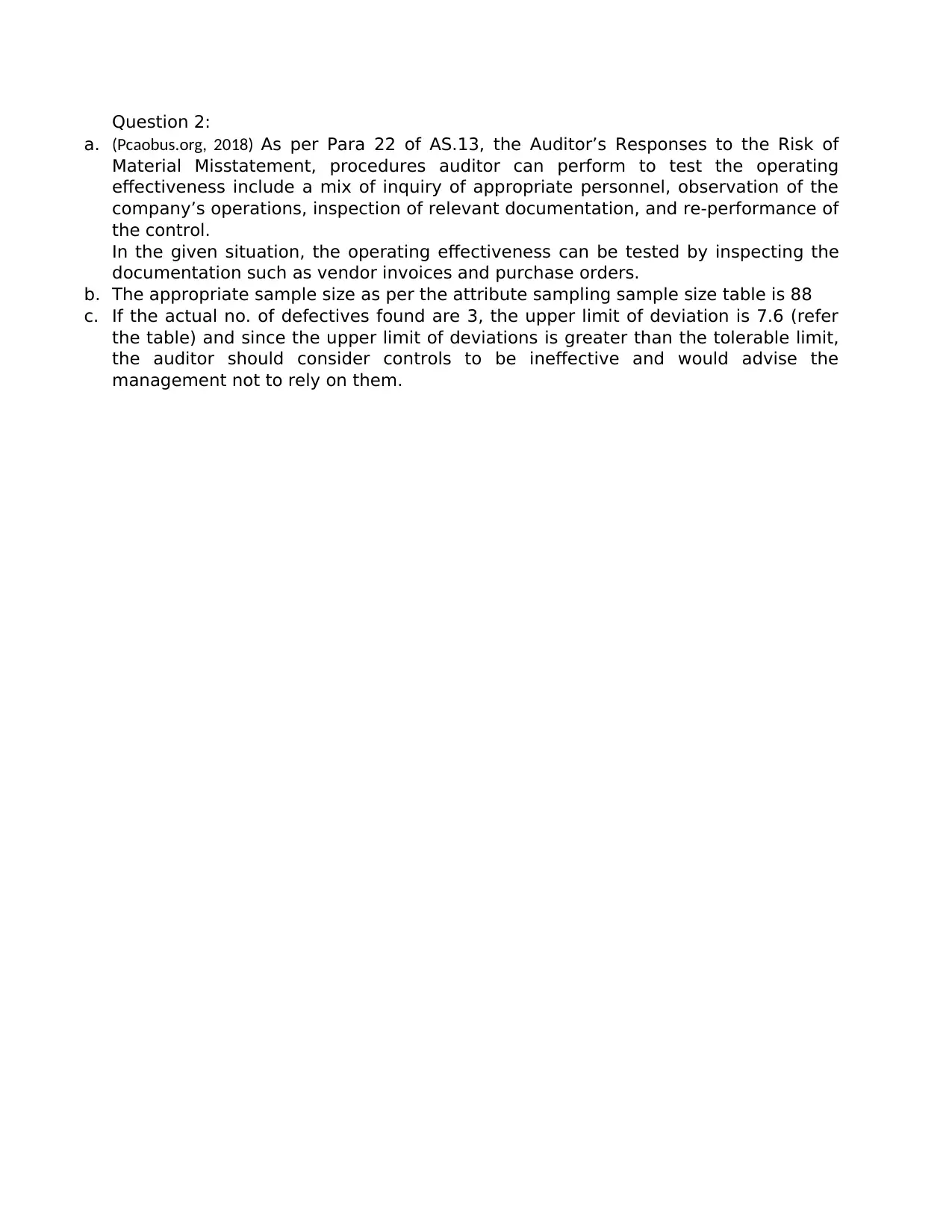
Question 2:
a. (Pcaobus.org, 2018) As per Para 22 of AS.13, the Auditor’s Responses to the Risk of
Material Misstatement, procedures auditor can perform to test the operating
effectiveness include a mix of inquiry of appropriate personnel, observation of the
company’s operations, inspection of relevant documentation, and re-performance of
the control.
In the given situation, the operating effectiveness can be tested by inspecting the
documentation such as vendor invoices and purchase orders.
b. The appropriate sample size as per the attribute sampling sample size table is 88
c. If the actual no. of defectives found are 3, the upper limit of deviation is 7.6 (refer
the table) and since the upper limit of deviations is greater than the tolerable limit,
the auditor should consider controls to be ineffective and would advise the
management not to rely on them.
a. (Pcaobus.org, 2018) As per Para 22 of AS.13, the Auditor’s Responses to the Risk of
Material Misstatement, procedures auditor can perform to test the operating
effectiveness include a mix of inquiry of appropriate personnel, observation of the
company’s operations, inspection of relevant documentation, and re-performance of
the control.
In the given situation, the operating effectiveness can be tested by inspecting the
documentation such as vendor invoices and purchase orders.
b. The appropriate sample size as per the attribute sampling sample size table is 88
c. If the actual no. of defectives found are 3, the upper limit of deviation is 7.6 (refer
the table) and since the upper limit of deviations is greater than the tolerable limit,
the auditor should consider controls to be ineffective and would advise the
management not to rely on them.
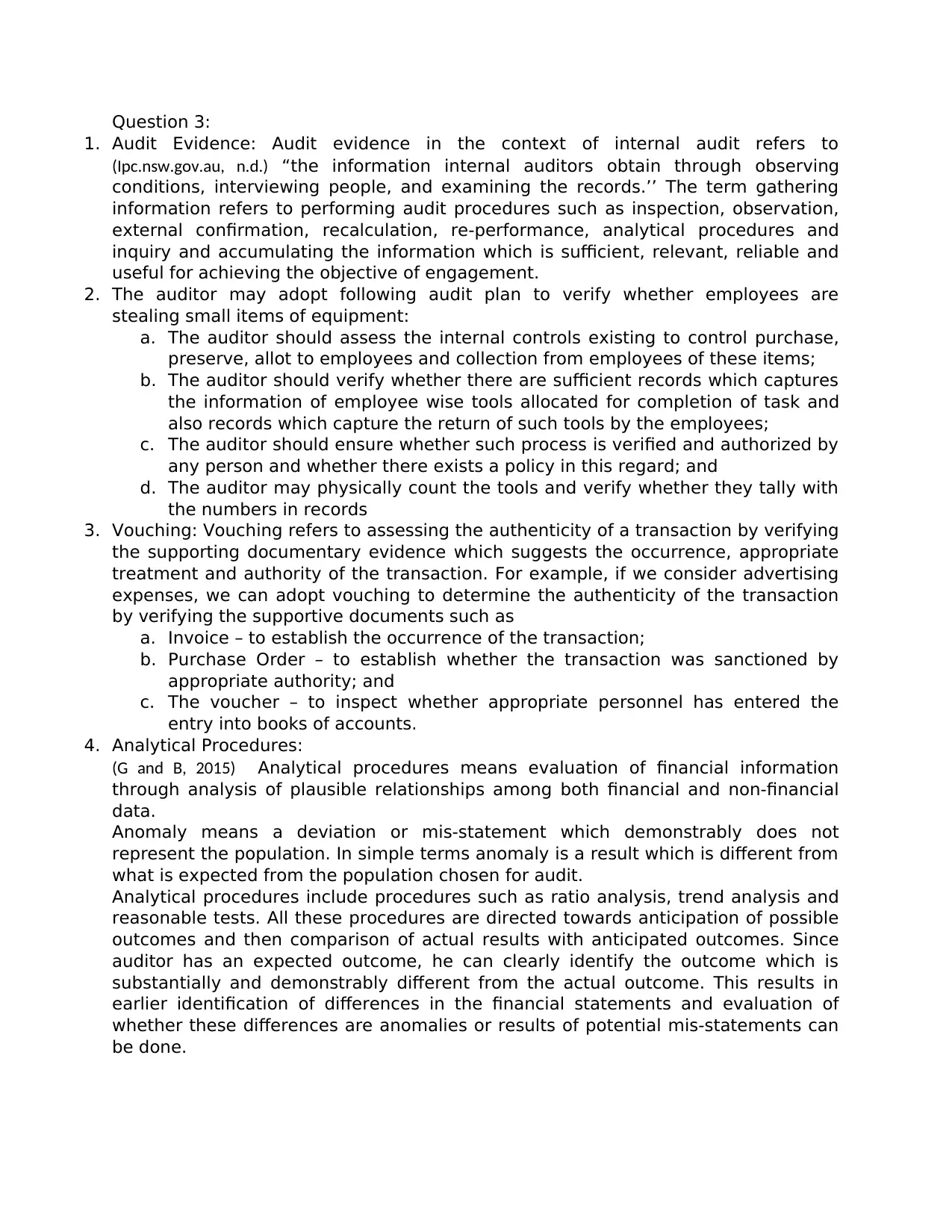
Question 3:
1. Audit Evidence: Audit evidence in the context of internal audit refers to
(Ipc.nsw.gov.au, n.d.) “the information internal auditors obtain through observing
conditions, interviewing people, and examining the records.’’ The term gathering
information refers to performing audit procedures such as inspection, observation,
external confirmation, recalculation, re-performance, analytical procedures and
inquiry and accumulating the information which is sufficient, relevant, reliable and
useful for achieving the objective of engagement.
2. The auditor may adopt following audit plan to verify whether employees are
stealing small items of equipment:
a. The auditor should assess the internal controls existing to control purchase,
preserve, allot to employees and collection from employees of these items;
b. The auditor should verify whether there are sufficient records which captures
the information of employee wise tools allocated for completion of task and
also records which capture the return of such tools by the employees;
c. The auditor should ensure whether such process is verified and authorized by
any person and whether there exists a policy in this regard; and
d. The auditor may physically count the tools and verify whether they tally with
the numbers in records
3. Vouching: Vouching refers to assessing the authenticity of a transaction by verifying
the supporting documentary evidence which suggests the occurrence, appropriate
treatment and authority of the transaction. For example, if we consider advertising
expenses, we can adopt vouching to determine the authenticity of the transaction
by verifying the supportive documents such as
a. Invoice – to establish the occurrence of the transaction;
b. Purchase Order – to establish whether the transaction was sanctioned by
appropriate authority; and
c. The voucher – to inspect whether appropriate personnel has entered the
entry into books of accounts.
4. Analytical Procedures:
(G and B, 2015) Analytical procedures means evaluation of financial information
through analysis of plausible relationships among both financial and non-financial
data.
Anomaly means a deviation or mis-statement which demonstrably does not
represent the population. In simple terms anomaly is a result which is different from
what is expected from the population chosen for audit.
Analytical procedures include procedures such as ratio analysis, trend analysis and
reasonable tests. All these procedures are directed towards anticipation of possible
outcomes and then comparison of actual results with anticipated outcomes. Since
auditor has an expected outcome, he can clearly identify the outcome which is
substantially and demonstrably different from the actual outcome. This results in
earlier identification of differences in the financial statements and evaluation of
whether these differences are anomalies or results of potential mis-statements can
be done.
1. Audit Evidence: Audit evidence in the context of internal audit refers to
(Ipc.nsw.gov.au, n.d.) “the information internal auditors obtain through observing
conditions, interviewing people, and examining the records.’’ The term gathering
information refers to performing audit procedures such as inspection, observation,
external confirmation, recalculation, re-performance, analytical procedures and
inquiry and accumulating the information which is sufficient, relevant, reliable and
useful for achieving the objective of engagement.
2. The auditor may adopt following audit plan to verify whether employees are
stealing small items of equipment:
a. The auditor should assess the internal controls existing to control purchase,
preserve, allot to employees and collection from employees of these items;
b. The auditor should verify whether there are sufficient records which captures
the information of employee wise tools allocated for completion of task and
also records which capture the return of such tools by the employees;
c. The auditor should ensure whether such process is verified and authorized by
any person and whether there exists a policy in this regard; and
d. The auditor may physically count the tools and verify whether they tally with
the numbers in records
3. Vouching: Vouching refers to assessing the authenticity of a transaction by verifying
the supporting documentary evidence which suggests the occurrence, appropriate
treatment and authority of the transaction. For example, if we consider advertising
expenses, we can adopt vouching to determine the authenticity of the transaction
by verifying the supportive documents such as
a. Invoice – to establish the occurrence of the transaction;
b. Purchase Order – to establish whether the transaction was sanctioned by
appropriate authority; and
c. The voucher – to inspect whether appropriate personnel has entered the
entry into books of accounts.
4. Analytical Procedures:
(G and B, 2015) Analytical procedures means evaluation of financial information
through analysis of plausible relationships among both financial and non-financial
data.
Anomaly means a deviation or mis-statement which demonstrably does not
represent the population. In simple terms anomaly is a result which is different from
what is expected from the population chosen for audit.
Analytical procedures include procedures such as ratio analysis, trend analysis and
reasonable tests. All these procedures are directed towards anticipation of possible
outcomes and then comparison of actual results with anticipated outcomes. Since
auditor has an expected outcome, he can clearly identify the outcome which is
substantially and demonstrably different from the actual outcome. This results in
earlier identification of differences in the financial statements and evaluation of
whether these differences are anomalies or results of potential mis-statements can
be done.
⊘ This is a preview!⊘
Do you want full access?
Subscribe today to unlock all pages.

Trusted by 1+ million students worldwide
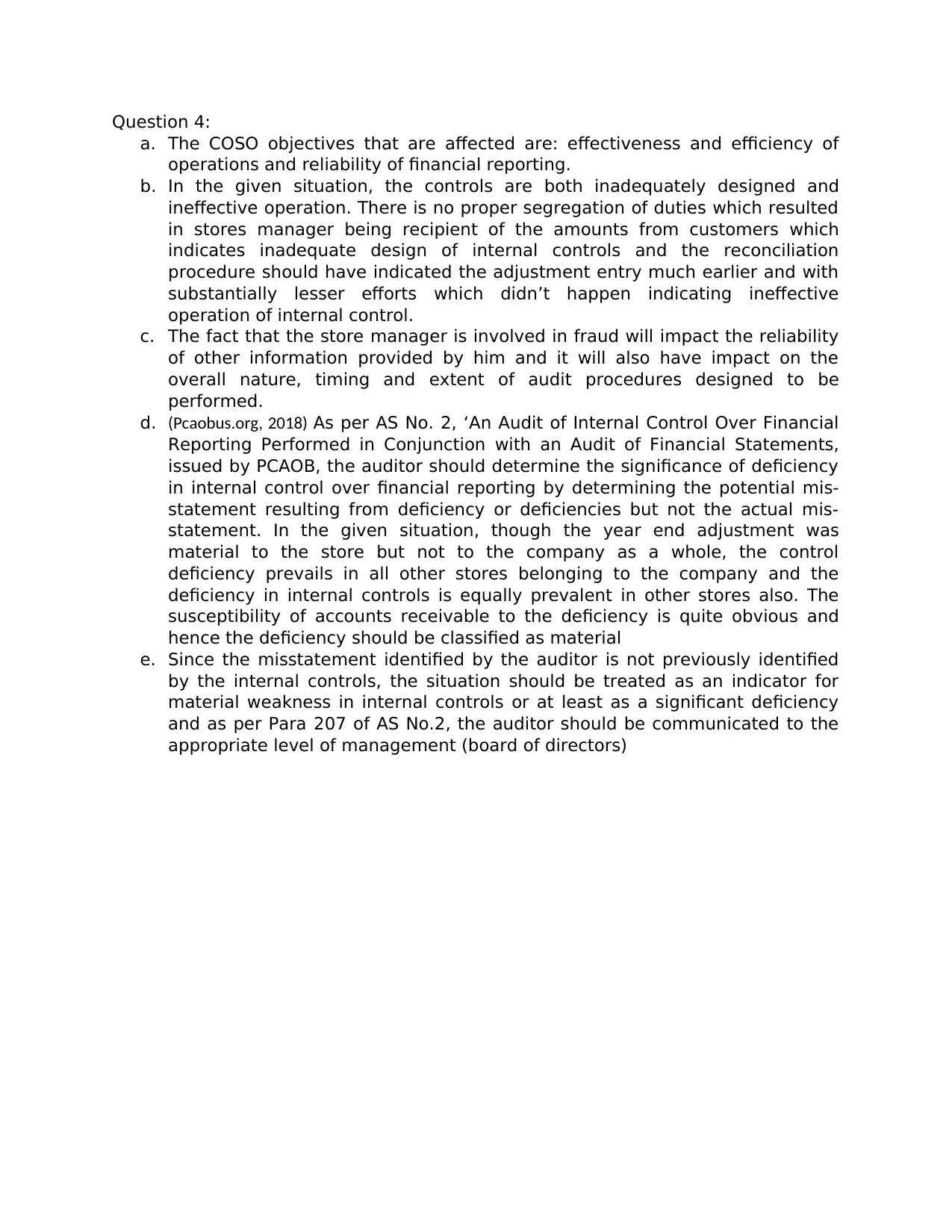
Question 4:
a. The COSO objectives that are affected are: effectiveness and efficiency of
operations and reliability of financial reporting.
b. In the given situation, the controls are both inadequately designed and
ineffective operation. There is no proper segregation of duties which resulted
in stores manager being recipient of the amounts from customers which
indicates inadequate design of internal controls and the reconciliation
procedure should have indicated the adjustment entry much earlier and with
substantially lesser efforts which didn’t happen indicating ineffective
operation of internal control.
c. The fact that the store manager is involved in fraud will impact the reliability
of other information provided by him and it will also have impact on the
overall nature, timing and extent of audit procedures designed to be
performed.
d. (Pcaobus.org, 2018) As per AS No. 2, ‘An Audit of Internal Control Over Financial
Reporting Performed in Conjunction with an Audit of Financial Statements,
issued by PCAOB, the auditor should determine the significance of deficiency
in internal control over financial reporting by determining the potential mis-
statement resulting from deficiency or deficiencies but not the actual mis-
statement. In the given situation, though the year end adjustment was
material to the store but not to the company as a whole, the control
deficiency prevails in all other stores belonging to the company and the
deficiency in internal controls is equally prevalent in other stores also. The
susceptibility of accounts receivable to the deficiency is quite obvious and
hence the deficiency should be classified as material
e. Since the misstatement identified by the auditor is not previously identified
by the internal controls, the situation should be treated as an indicator for
material weakness in internal controls or at least as a significant deficiency
and as per Para 207 of AS No.2, the auditor should be communicated to the
appropriate level of management (board of directors)
a. The COSO objectives that are affected are: effectiveness and efficiency of
operations and reliability of financial reporting.
b. In the given situation, the controls are both inadequately designed and
ineffective operation. There is no proper segregation of duties which resulted
in stores manager being recipient of the amounts from customers which
indicates inadequate design of internal controls and the reconciliation
procedure should have indicated the adjustment entry much earlier and with
substantially lesser efforts which didn’t happen indicating ineffective
operation of internal control.
c. The fact that the store manager is involved in fraud will impact the reliability
of other information provided by him and it will also have impact on the
overall nature, timing and extent of audit procedures designed to be
performed.
d. (Pcaobus.org, 2018) As per AS No. 2, ‘An Audit of Internal Control Over Financial
Reporting Performed in Conjunction with an Audit of Financial Statements,
issued by PCAOB, the auditor should determine the significance of deficiency
in internal control over financial reporting by determining the potential mis-
statement resulting from deficiency or deficiencies but not the actual mis-
statement. In the given situation, though the year end adjustment was
material to the store but not to the company as a whole, the control
deficiency prevails in all other stores belonging to the company and the
deficiency in internal controls is equally prevalent in other stores also. The
susceptibility of accounts receivable to the deficiency is quite obvious and
hence the deficiency should be classified as material
e. Since the misstatement identified by the auditor is not previously identified
by the internal controls, the situation should be treated as an indicator for
material weakness in internal controls or at least as a significant deficiency
and as per Para 207 of AS No.2, the auditor should be communicated to the
appropriate level of management (board of directors)
Paraphrase This Document
Need a fresh take? Get an instant paraphrase of this document with our AI Paraphraser
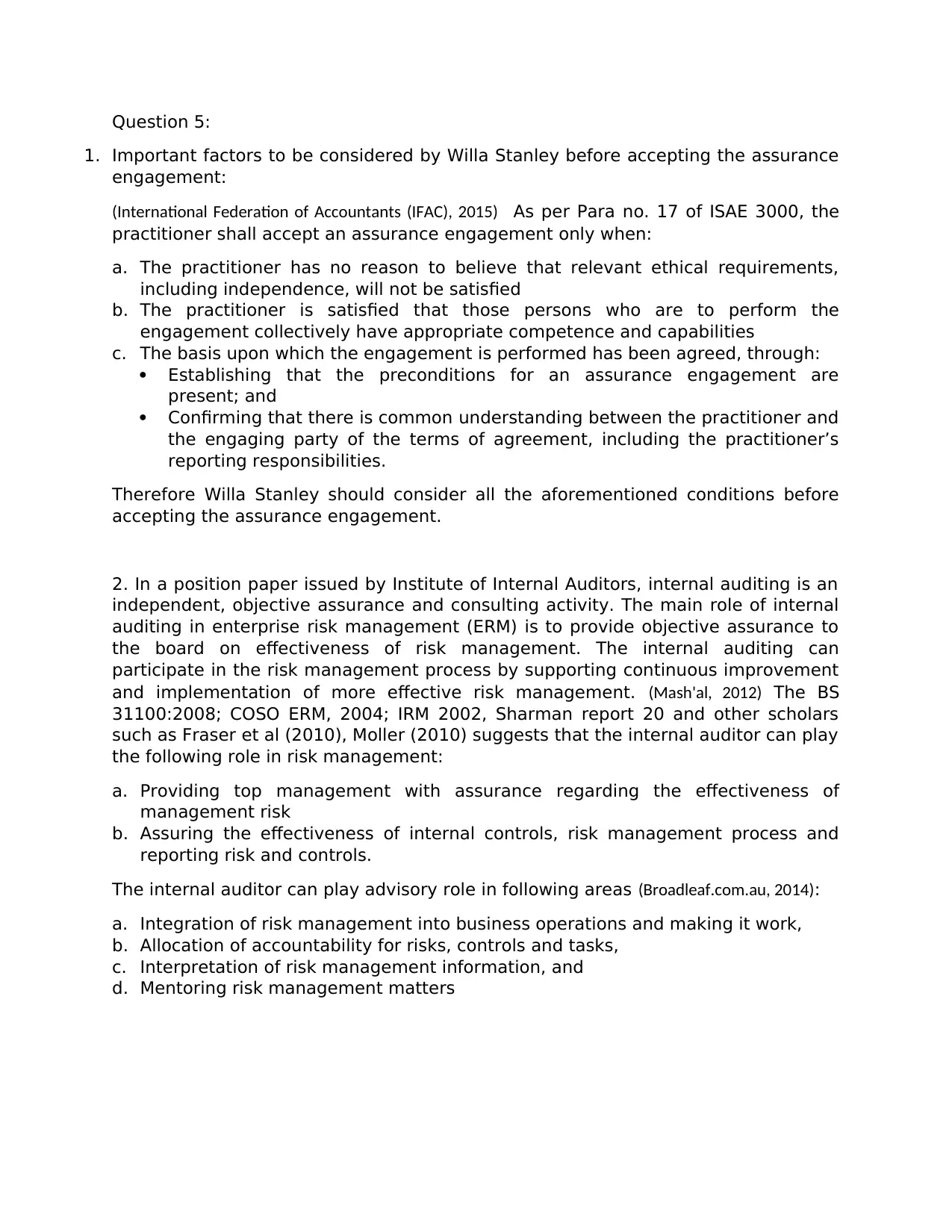
Question 5:
1. Important factors to be considered by Willa Stanley before accepting the assurance
engagement:
(International Federation of Accountants (IFAC), 2015) As per Para no. 17 of ISAE 3000, the
practitioner shall accept an assurance engagement only when:
a. The practitioner has no reason to believe that relevant ethical requirements,
including independence, will not be satisfied
b. The practitioner is satisfied that those persons who are to perform the
engagement collectively have appropriate competence and capabilities
c. The basis upon which the engagement is performed has been agreed, through:
Establishing that the preconditions for an assurance engagement are
present; and
Confirming that there is common understanding between the practitioner and
the engaging party of the terms of agreement, including the practitioner’s
reporting responsibilities.
Therefore Willa Stanley should consider all the aforementioned conditions before
accepting the assurance engagement.
2. In a position paper issued by Institute of Internal Auditors, internal auditing is an
independent, objective assurance and consulting activity. The main role of internal
auditing in enterprise risk management (ERM) is to provide objective assurance to
the board on effectiveness of risk management. The internal auditing can
participate in the risk management process by supporting continuous improvement
and implementation of more effective risk management. (Mash'al, 2012) The BS
31100:2008; COSO ERM, 2004; IRM 2002, Sharman report 20 and other scholars
such as Fraser et al (2010), Moller (2010) suggests that the internal auditor can play
the following role in risk management:
a. Providing top management with assurance regarding the effectiveness of
management risk
b. Assuring the effectiveness of internal controls, risk management process and
reporting risk and controls.
The internal auditor can play advisory role in following areas (Broadleaf.com.au, 2014):
a. Integration of risk management into business operations and making it work,
b. Allocation of accountability for risks, controls and tasks,
c. Interpretation of risk management information, and
d. Mentoring risk management matters
1. Important factors to be considered by Willa Stanley before accepting the assurance
engagement:
(International Federation of Accountants (IFAC), 2015) As per Para no. 17 of ISAE 3000, the
practitioner shall accept an assurance engagement only when:
a. The practitioner has no reason to believe that relevant ethical requirements,
including independence, will not be satisfied
b. The practitioner is satisfied that those persons who are to perform the
engagement collectively have appropriate competence and capabilities
c. The basis upon which the engagement is performed has been agreed, through:
Establishing that the preconditions for an assurance engagement are
present; and
Confirming that there is common understanding between the practitioner and
the engaging party of the terms of agreement, including the practitioner’s
reporting responsibilities.
Therefore Willa Stanley should consider all the aforementioned conditions before
accepting the assurance engagement.
2. In a position paper issued by Institute of Internal Auditors, internal auditing is an
independent, objective assurance and consulting activity. The main role of internal
auditing in enterprise risk management (ERM) is to provide objective assurance to
the board on effectiveness of risk management. The internal auditing can
participate in the risk management process by supporting continuous improvement
and implementation of more effective risk management. (Mash'al, 2012) The BS
31100:2008; COSO ERM, 2004; IRM 2002, Sharman report 20 and other scholars
such as Fraser et al (2010), Moller (2010) suggests that the internal auditor can play
the following role in risk management:
a. Providing top management with assurance regarding the effectiveness of
management risk
b. Assuring the effectiveness of internal controls, risk management process and
reporting risk and controls.
The internal auditor can play advisory role in following areas (Broadleaf.com.au, 2014):
a. Integration of risk management into business operations and making it work,
b. Allocation of accountability for risks, controls and tasks,
c. Interpretation of risk management information, and
d. Mentoring risk management matters

Question 7:
1. Ways to measure the quality of work of internal audit department:
a. Internal Methods:
Balanced Score Card: Balanced score card is a strategic planning and
management tool that can be used to keep track of the execution of activities
and to monitor the consequences arising from these activities. It is an
example of a closed-loop controller where actual performance of internal
audit is measured, the measured value is compared to a reference value and
based on the difference between the two corrective interventions, the
requirement and scope for improvement of the internal audit function is
framed.
Customer Surveys: A survey can be sent to the managers with scoring
dimensions such as professionalism, quality of counsel, timeliness of work,
utility of meetings, and quality of status updates, etc., can be sent after each
internal audit engagement to measure the performance of the internal audit
b. External Methods
Peer review is nothing but review of work of a professional by another
professional with same level of knowledge. In many cases such review is a
requirement of standard. Usually peer review is done by an external
professional who is independent of regular internal auditing activities of the
company. Peer review can serve as an effective way of determining the
overall quality of internal audit function
2. (Cleanenergyregulator.gov.au, 2018) The audit team should consider the following factors
during the planning stage of the engagement:
a. Preliminary understanding of audited body and its environment: Auditor
should perform risk assessment procedures and preliminary analytical
procedures. Further the auditor should also assess the client’s system,
process and controls.
b. Materiality: After obtaining preliminary understanding, the audit team should
set the materiality for the overall engagement
c. Nature, timing and extent of audit procedures: With the results from risk
assessment and after setting up the materiality level, the audit team should
consider the nature, timing and extent of evidence gathering procedures in
developing the assurance engagement plan.
1. Ways to measure the quality of work of internal audit department:
a. Internal Methods:
Balanced Score Card: Balanced score card is a strategic planning and
management tool that can be used to keep track of the execution of activities
and to monitor the consequences arising from these activities. It is an
example of a closed-loop controller where actual performance of internal
audit is measured, the measured value is compared to a reference value and
based on the difference between the two corrective interventions, the
requirement and scope for improvement of the internal audit function is
framed.
Customer Surveys: A survey can be sent to the managers with scoring
dimensions such as professionalism, quality of counsel, timeliness of work,
utility of meetings, and quality of status updates, etc., can be sent after each
internal audit engagement to measure the performance of the internal audit
b. External Methods
Peer review is nothing but review of work of a professional by another
professional with same level of knowledge. In many cases such review is a
requirement of standard. Usually peer review is done by an external
professional who is independent of regular internal auditing activities of the
company. Peer review can serve as an effective way of determining the
overall quality of internal audit function
2. (Cleanenergyregulator.gov.au, 2018) The audit team should consider the following factors
during the planning stage of the engagement:
a. Preliminary understanding of audited body and its environment: Auditor
should perform risk assessment procedures and preliminary analytical
procedures. Further the auditor should also assess the client’s system,
process and controls.
b. Materiality: After obtaining preliminary understanding, the audit team should
set the materiality for the overall engagement
c. Nature, timing and extent of audit procedures: With the results from risk
assessment and after setting up the materiality level, the audit team should
consider the nature, timing and extent of evidence gathering procedures in
developing the assurance engagement plan.
⊘ This is a preview!⊘
Do you want full access?
Subscribe today to unlock all pages.

Trusted by 1+ million students worldwide
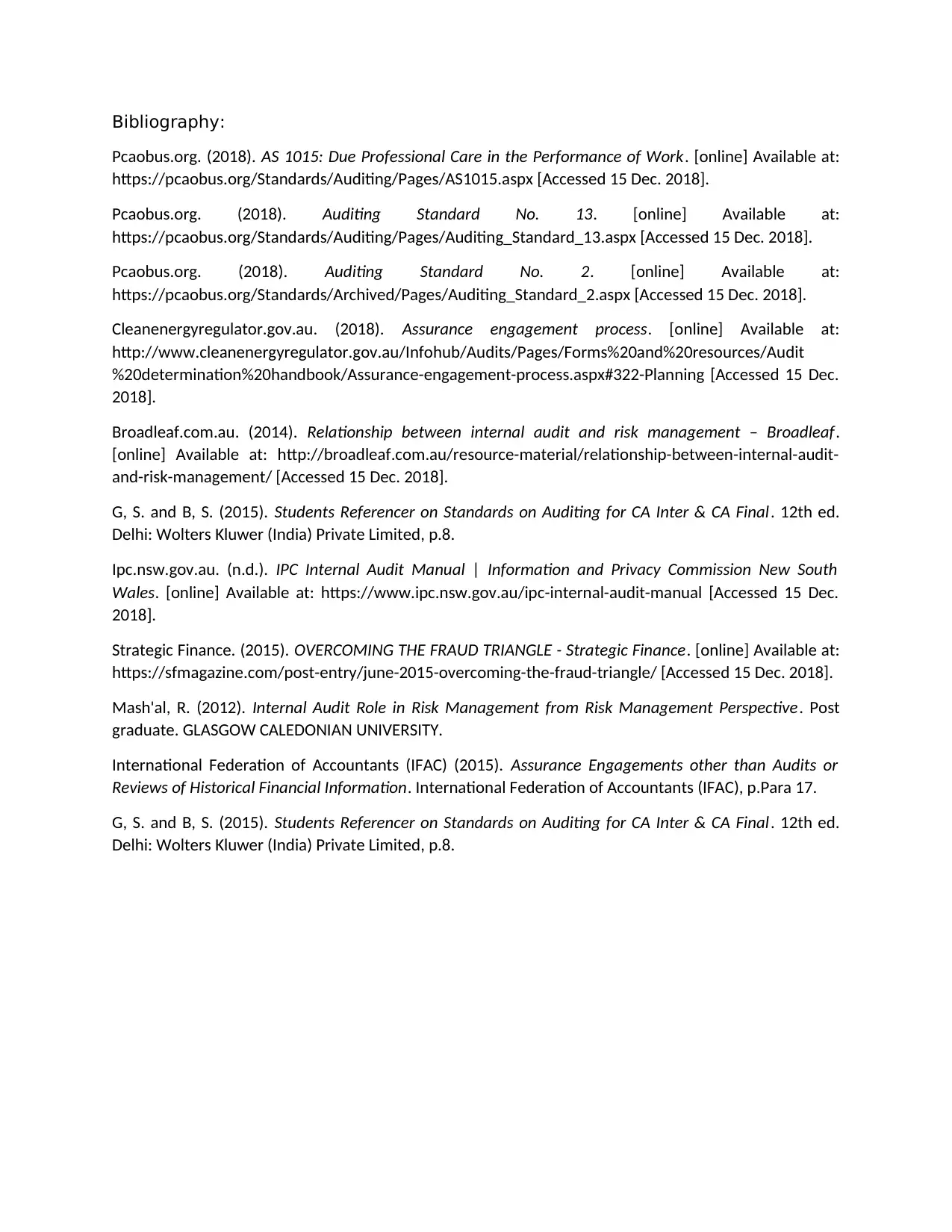
Bibliography:
Pcaobus.org. (2018). AS 1015: Due Professional Care in the Performance of Work. [online] Available at:
https://pcaobus.org/Standards/Auditing/Pages/AS1015.aspx [Accessed 15 Dec. 2018].
Pcaobus.org. (2018). Auditing Standard No. 13. [online] Available at:
https://pcaobus.org/Standards/Auditing/Pages/Auditing_Standard_13.aspx [Accessed 15 Dec. 2018].
Pcaobus.org. (2018). Auditing Standard No. 2. [online] Available at:
https://pcaobus.org/Standards/Archived/Pages/Auditing_Standard_2.aspx [Accessed 15 Dec. 2018].
Cleanenergyregulator.gov.au. (2018). Assurance engagement process. [online] Available at:
http://www.cleanenergyregulator.gov.au/Infohub/Audits/Pages/Forms%20and%20resources/Audit
%20determination%20handbook/Assurance-engagement-process.aspx#322-Planning [Accessed 15 Dec.
2018].
Broadleaf.com.au. (2014). Relationship between internal audit and risk management – Broadleaf.
[online] Available at: http://broadleaf.com.au/resource-material/relationship-between-internal-audit-
and-risk-management/ [Accessed 15 Dec. 2018].
G, S. and B, S. (2015). Students Referencer on Standards on Auditing for CA Inter & CA Final. 12th ed.
Delhi: Wolters Kluwer (India) Private Limited, p.8.
Ipc.nsw.gov.au. (n.d.). IPC Internal Audit Manual | Information and Privacy Commission New South
Wales. [online] Available at: https://www.ipc.nsw.gov.au/ipc-internal-audit-manual [Accessed 15 Dec.
2018].
Strategic Finance. (2015). OVERCOMING THE FRAUD TRIANGLE - Strategic Finance. [online] Available at:
https://sfmagazine.com/post-entry/june-2015-overcoming-the-fraud-triangle/ [Accessed 15 Dec. 2018].
Mash'al, R. (2012). Internal Audit Role in Risk Management from Risk Management Perspective. Post
graduate. GLASGOW CALEDONIAN UNIVERSITY.
International Federation of Accountants (IFAC) (2015). Assurance Engagements other than Audits or
Reviews of Historical Financial Information. International Federation of Accountants (IFAC), p.Para 17.
G, S. and B, S. (2015). Students Referencer on Standards on Auditing for CA Inter & CA Final. 12th ed.
Delhi: Wolters Kluwer (India) Private Limited, p.8.
Pcaobus.org. (2018). AS 1015: Due Professional Care in the Performance of Work. [online] Available at:
https://pcaobus.org/Standards/Auditing/Pages/AS1015.aspx [Accessed 15 Dec. 2018].
Pcaobus.org. (2018). Auditing Standard No. 13. [online] Available at:
https://pcaobus.org/Standards/Auditing/Pages/Auditing_Standard_13.aspx [Accessed 15 Dec. 2018].
Pcaobus.org. (2018). Auditing Standard No. 2. [online] Available at:
https://pcaobus.org/Standards/Archived/Pages/Auditing_Standard_2.aspx [Accessed 15 Dec. 2018].
Cleanenergyregulator.gov.au. (2018). Assurance engagement process. [online] Available at:
http://www.cleanenergyregulator.gov.au/Infohub/Audits/Pages/Forms%20and%20resources/Audit
%20determination%20handbook/Assurance-engagement-process.aspx#322-Planning [Accessed 15 Dec.
2018].
Broadleaf.com.au. (2014). Relationship between internal audit and risk management – Broadleaf.
[online] Available at: http://broadleaf.com.au/resource-material/relationship-between-internal-audit-
and-risk-management/ [Accessed 15 Dec. 2018].
G, S. and B, S. (2015). Students Referencer on Standards on Auditing for CA Inter & CA Final. 12th ed.
Delhi: Wolters Kluwer (India) Private Limited, p.8.
Ipc.nsw.gov.au. (n.d.). IPC Internal Audit Manual | Information and Privacy Commission New South
Wales. [online] Available at: https://www.ipc.nsw.gov.au/ipc-internal-audit-manual [Accessed 15 Dec.
2018].
Strategic Finance. (2015). OVERCOMING THE FRAUD TRIANGLE - Strategic Finance. [online] Available at:
https://sfmagazine.com/post-entry/june-2015-overcoming-the-fraud-triangle/ [Accessed 15 Dec. 2018].
Mash'al, R. (2012). Internal Audit Role in Risk Management from Risk Management Perspective. Post
graduate. GLASGOW CALEDONIAN UNIVERSITY.
International Federation of Accountants (IFAC) (2015). Assurance Engagements other than Audits or
Reviews of Historical Financial Information. International Federation of Accountants (IFAC), p.Para 17.
G, S. and B, S. (2015). Students Referencer on Standards on Auditing for CA Inter & CA Final. 12th ed.
Delhi: Wolters Kluwer (India) Private Limited, p.8.
1 out of 7
Your All-in-One AI-Powered Toolkit for Academic Success.
+13062052269
info@desklib.com
Available 24*7 on WhatsApp / Email
![[object Object]](/_next/static/media/star-bottom.7253800d.svg)
Unlock your academic potential
© 2024 | Zucol Services PVT LTD | All rights reserved.